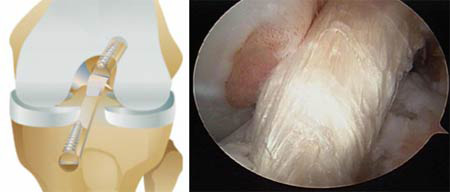ACL Injuries
Eric Pifel, MD
The Orthopedic Institute of Wisconsin
What is the ACL?
The Anterior Cruciate Ligament (ACL) is the large ligament in the center of the knee which provides stability for many motions, especially side to side activities
It does this by limiting the motion of the tibia (shin bone) on the femur (thigh bone)
Why is the ACL necessary?
It stabilizes the knee during cutting, twisting, turning, and jumping activities.
A stable knee is protected against other injuries and early degenerative changes.

Fig 1: Normal arthroscopic view of intact ACL
How is the ACL Injured?
- Non-contact planting (stepping) injuries of the foot during sports
- Contact injury to the knee, most commonly valgus (knock-knee) stress to the knee
- Motor vehicle injury
- Work twisting injury with a heavy load

Fig 2: ACL Tear with instrument showing laxity or looseness of the ligament
What happens without an ACL?
- The knee become lax or loose
- There can be increased pain with this looseness
- The other structures of the knee are placed at risk for injury including the meniscus (shock absorbing cartilage), articular cartilage (arthritis cartilage), and other ligaments
What can be done when an ACL is injured?
- ACL’s cannot heal because their blood supplies are limited.
- Most people cannot function to the level they previously had without the stability the ACL provides to the knee.
- Some low demand patients or severely arthritic patients can exist without an ACL.
- However, most people need to have the ACL reconstructed.
ACL Reconstruction
- ACL cannot be repaired, but can be recreated by using other tissues to act as the ACL.
- These tissues most commonly include the hamstring tendons, the patellar tendon, and a tissue from tissue donors.
- The new reconstruction tissue is aligned within the knee to recreate the native ACL and is then fixed to the bone to allow healing.

Fig 3: Removal of Hamstring Tendons for ACL Reconstruction (image courtesy of Arthex, Inc.)
What to expect after an ACL reconstruction
- Typically, the ACL reconstruction is done as an outpatient or home the same day surgery.
- Most patients are on crutches for 10-14 days and begin therapy within the first week after surgery.
- Therapy is a three to six month process of increasing strength, mobility, stability, and endurance for the leg. It is less and less frequent on a weekly basis as time passes.
- Most people are able to return to their previous level of activity between 4-6 months after surgery.

Fig 4: Schematic and intraoperative picture of ACL reconstruction with screw fixation. (image courtesy of Arthrex, Inc.)
What are the risks of ACL surgery?
The risks in ACL surgery are small but some risks include infection, stiffness, re-tear in the ACL, inability to return to the previous level of function, blood clots, or injury to the neurovascular structures about the knee.
Conclusion
ACL injury is unfortunately very common in the active patient. However, there are excellent methods to treat this injury and get people back to their activities.
Disclaimer
This web site contains general medical information and does not replace the medical advice of your physician. If you have questions about your medical condition or exercises, ask your doctor or health care provider.
